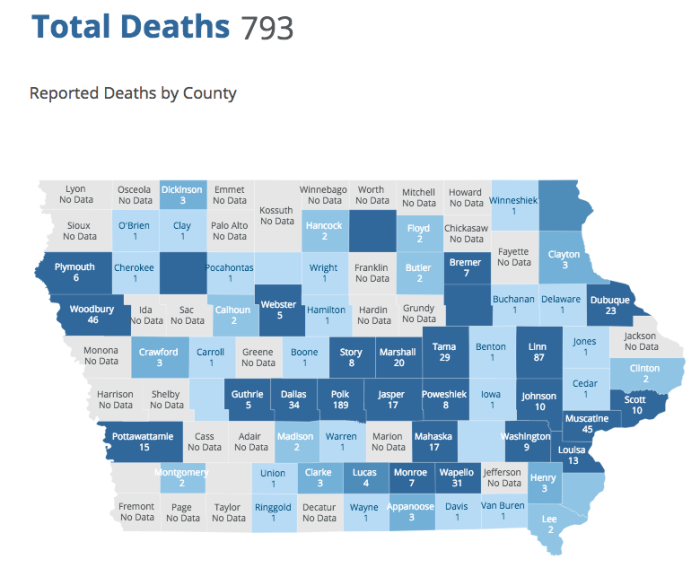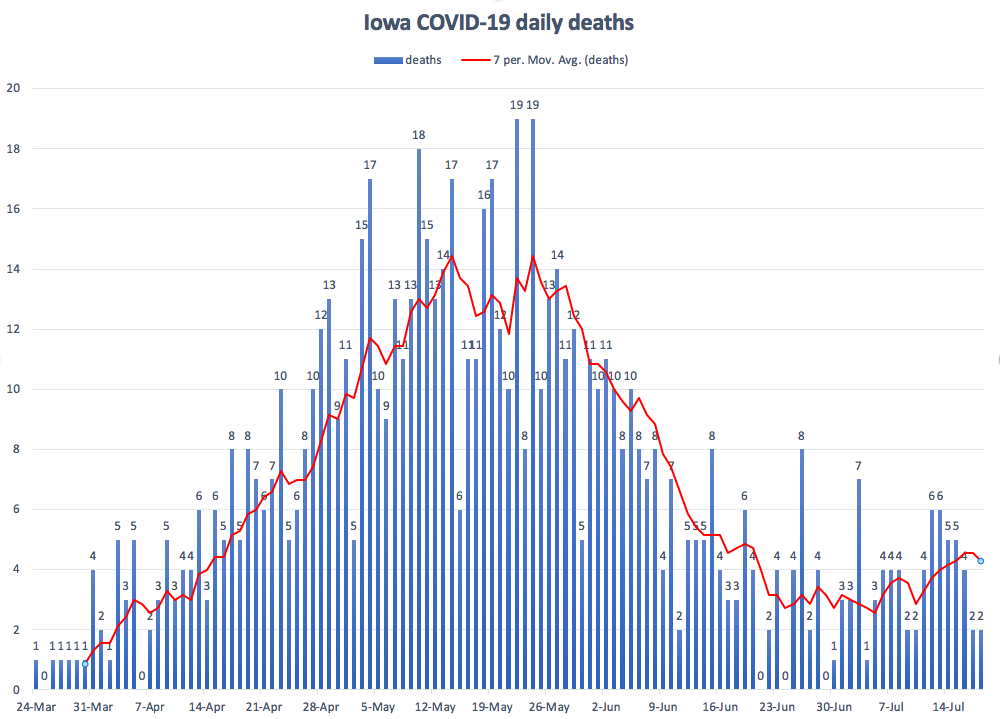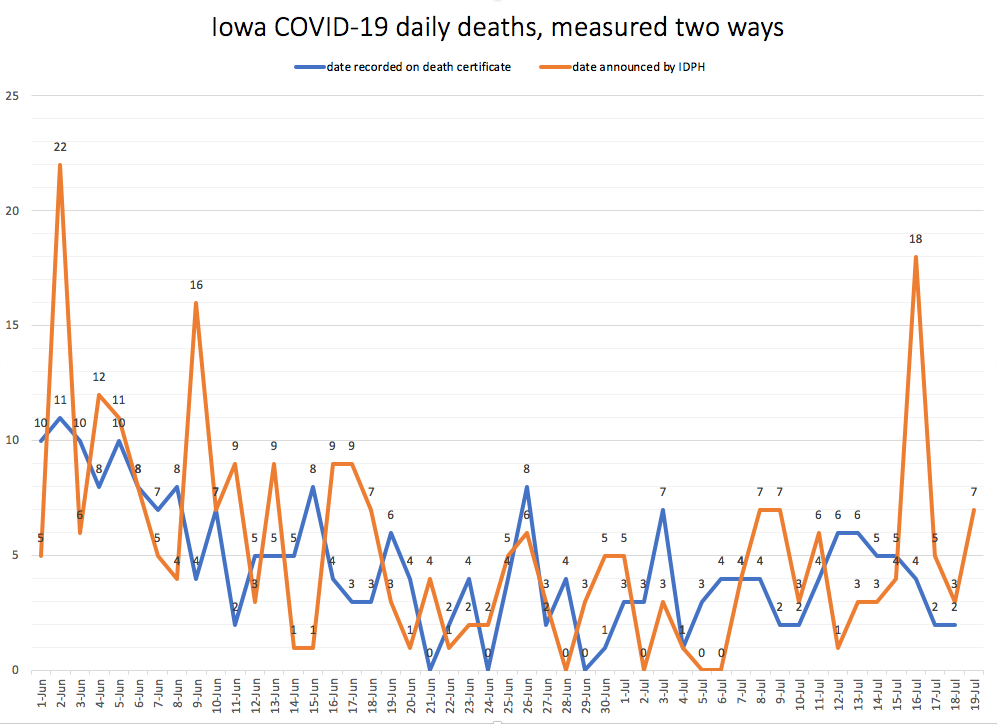This project started with the goal of clearing up some confusion surrounding Iowa’s novel coronavirus (COVID-19) death statistics.
Specifically, I wanted to debunk a conspiracy theory making the rounds on Facebook, Twitter, and Reddit.
I also planned to explain why the number of deaths for a given day on the state’s official website (coronavirus.iowa.gov) didn’t always match the number of new deaths that had been announced on that date. Many readers had asked about the discrepancy.
I was almost ready to publish in early July, but I needed to nail down one detail. Did the total fatalities on the state website (793 at this writing) reflect all of what the U.S. Centers for Disease Control describes as “multiple cause” COVID-19 deaths, or only what the CDC labels “underlying cause” deaths?
After asking that question more than half a dozen times over two and a half weeks, I still haven’t received an answer. So much for the Iowa Department of Public Health’s supposed “transparency” and “constant communication with media” on the pandemic.
CDC REPORTS TWO SETS OF NUMBERS FOR COVID-19 DEATHS
The CDC publishes “weekly provisional counts of death for COVID-19” in each state as part of a larger table displaying “weekly counts of deaths by state and select cause.” The table includes two columns for COVID-19: “Multiple Cause of Death” and “Underlying Cause of Death.”
There’s a time lag in the information flow from states to the CDC. Although Iowa recorded its first COVID-19 death on March 24, the first numbers for our state appear on the CDC table for the week ending April 4. On the same page, the most recent Iowa COVID-19 fatality data is for the week ending June 20. The IDPH has announced more than 100 additional deaths since then.
Because the CDC table is too large to display on one screen, I created this table using the COVID-19 data that appeared on the federal website as of July 19.
| CDC data on Iowa’s COVID-19 deaths in 2020 | ||
| Week ending date | COVID-19 deaths (multiple causes) | COVID-19 deaths (underlying cause) |
|---|---|---|
| April 4 | 17 | 16 |
| April 11 | 21 | 20 |
| April 18 | 36 | 36 |
| April 25 | 49 | 46 |
| May 2 | 62 | 59 |
| May 9 | 89 | 81 |
| May 16 | 101 | 94 |
| May 23 | 101 | 93 |
| May 30 | 87 | 82 |
| June 6 | 65 | 62 |
| June 13 | 37 | 32 |
| June 20 | 21 | 19 |
| total | 686 | 640 |
The two sets of numbers led some to assume that these columns referenced different groups of COVID-19 patients in Iowa, and that state health officials were leaving out everyone in the “multiple cause” group. In late June, I saw several widely-shared posts on social media alleging that Iowa’s real coronavirus death toll was twice as large as the Department of Public Health was letting on.
It seemed more likely that the “underlying cause” deaths were a subset of the deaths from multiple causes. I reached out to the CDC press room. If the table shows 17 multiple cause deaths and 16 underlying cause deaths from COVID-19 for a given week in Iowa, does that mean seventeen Iowans died that week of the virus, and one of them had another condition that contributed to the death? Or does it mean that 33 Iowans died with COVID-19 during that week, of whom seventeen had multiple life-threatening conditions and sixteen had only coronavirus when they died?
The CDC must get hundreds of media inquiries every day, but I received an answer within hours from Jeff Lancashire, public affairs officer for the CDC’s National Center for Health Statistics. He wrote,
The multiple cause and underlying cause numbers should not be added together. The underlying cause count is a subset of the multiple cause count. Adding the two numbers would double count the underlying cause number.
Lancashire noted that it’s “not quite correct” to say the multiple cause number reflects how many Iowans died that week with a COVID-19 diagnosis. Using a different week’s numbers by way of example, he said (emphasis in original),
A correct interpretation for Iowa would be:
“…this means 49 Iowans died from COVID-19 that week, of whom 45 had COVID-19 as the underlying cause and another 4 had COVID-9 reported as a contributing factor.”
It is important to note that the death certificate is designed to elicit only those conditions that caused or contributed to death. It does not indicate the number that died with (i.e., that had) COVID-19. Simply testing positive for COVID-19 is not sufficient for inclusion on the death certificate. If COVID-19 is not a cause of death or contributory factor, it should not be reported on the death certificate.
That’s sensible. Someone who has COVID-19 and dies in an unrelated way (for instance, in an accident) will not be recorded as a coronavirus fatality.
Lancashire further explained,
“Multiple cause” in this case indicates that we are counting from the multiple cause fields, i.e., we are selecting cases with any mention of COVID-19, regardless whether it was the underlying cause or not. Underlying cause indicates that among all conditions reported on the death certificate, COVID-19 was the underlying cause of death. When COVID-19 is reported on the death certificate, but is not the underlying cause, it can be described as a factor contributing to death.
Case closed: the IDPH hasn’t been massively underreporting the number of COVID-19 deaths.
Now I just needed to confirm whether the numbers on the state website include all “multiple cause” deaths or only “underlying cause” ones. The relevant tab on the website is labeled “summary dashboard of COVID-19 cases resulting in death.” What does that mean exactly?
If the state was reporting only “underlying cause” deaths, then it was leaving out several deaths per week where coronavirus was a contributing factor. Over time, that adds up. As the table above shows, the CDC reported 46 more “multiple cause” than “underlying cause” deaths for Iowa from early April through the third week in June.
NO ANSWERS FORTHCOMING
The CDC couldn’t say how Iowa is categorizing deaths, but Lancashire forwarded this response from the mortality statistics branch of the National Center for Health Statistics.
The Iowa Dept of Public Health is probably reporting based on case surveillance, not death certificates. Since we (NCHS) do the coding and assign the underlying cause, the IDPH counts are not likely based on underlying cause.
Sounds reasonable. If true, the numbers on coronavirus.iowa.gov include all “multiple cause” deaths, and the state is not systematically lowballing COVID-19 deaths.
I awaited confirmation from the IDPH.
Amy McCoy, who took over handling COVID-19 media inquiries for the department in March, is not known for being consistently helpful. Although she was once a journalist herself, she “doesn’t acknowledge or respond to some media requests for information.” No particular news organization is singled out. Every reporter covering the pandemic in Iowa has had some emails or phone calls go unreturned.
Sometimes McCoy will answer an initial question with a boilerplate written statement, then ignore follow-up questions for days. Other inquiries produce no response, not even “no comment.”
I’m used to not hearing back from McCoy on sensitive topics such as:
Nevertheless, I had realistic hope of learning how the department was counting COVID-19 deaths. After all, I was looking to disprove claims that the state was disclosing only half the fatalities. When I’d reached out to McCoy in May regarding conservative fear-mongering about forced vaccinations, she had replied right away to set the record straight.
To my surprise, my inquiries about “underlying” and “multiple cause” COVID-19 deaths went into a black hole. Here’s most of the correspondence, starting on July 1 when the state website was showing 717 total deaths.
I also wrote separately to McCoy on July 2, forwarding messages from the CDC’s Lancashire.
The week of July 6, McCoy was on vacation, and her back-up told me he would “do some checking and get back to you on your question.” He went silent shortly thereafter, not replying to several follow-up emails.
I tried once more on July 16, this time copying Governor Kim Reynolds’ communications director Pat Garrett. According to Polly Carver-Kimm, who was sidelined in March as the IDPH’s point of contact for reporters and lost her job with the department last week, “Reynolds’ staff has recently required most media requests, including routine open-records requests, to be funneled through the governor’s office.”
Still no answer.
“TRANSPARENCY IS CRITICAL IN OUR RESPONSE TO THE COVID-19 PANDEMIC”
On the morning of July 16, McCoy sent the following written statement to some reporters who had covered Carver-Kimm’s ouster. (emphasis added)
Transparency is critical in our response to the COVID-19 pandemic. The Iowa Department of Public Health has gone above and beyond to provide up-to-date and comprehensive information throughout the pandemic. These efforts have included participating in regular press briefings, constant communication with media and continuous improvement on how we report data and provide information. We value the role media plays in the state’s efforts to get information to the public, and intend to continue a strong partnership.
Journalists shouldn’t be stenographers, transmitting only what state officials want Iowans to know about the pandemic. Reporters have rightly pursued lots of newsworthy stories the state doesn’t want covered. The IDPH has responded by charging exorbitant fees for public records, claiming some documents are exempt from the open records law, removing some data from public view, or not answering questions about various important angles.
I’m not looking for a “strong partnership” with a state agency. I’m trying to inform my readers about topics that may concern them–in this case, how Iowa counts coronavirus fatalities.
Maybe some other reporter can unravel the mystery. While they’re at it, they may want to ask why the CDC table doesn’t show any COVID-19 deaths for Iowa after the week ending June 20. Columns on some other causes (cancer, heart disease, stroke) show totals for the week ending June 27 and/or the week ending July 4.
I asked the CDC about their typical process for collecting mortality data from state public health departments. Is it common for the COVID-19 numbers to lag by some amount of time? Lancashire said, “The death certificate counts lag the case surveillance by however long it takes the state to send us the data and for it to be coded.”
EXPLAINING THE DISCREPANCY IN DEATHS PER DAY
For the first two months of the pandemic, the IDPH and governor’s office announced new COVID-19 case and death numbers once daily, usually around 10:00 am. Many people began tracking those figures on their own spreadsheets. In early May, the state changed how it compiled data for the website, and soon after began updating throughout the day, often correcting totals going back a week to ten days.
Some reporters and analysts continue to track daily cases and deaths by the change in what the state website showed from a specific time on one day to the same time the next day.
I have shifted to tracking the numbers by how they appear on the website: cases by the date on which the positive test was conducted, and deaths by the date on the death certificate. An epidemiologist told me it’s more useful to know when people died of the virus than when the IDPH happened to update the totals.
I created this graph using the daily death totals that appeared on the state website on the evening of July 19. The red line represents the seven-day moving average in daily deaths.
This next graph illustrates why people are often confused when trying to calculate how many Iowans have died during a given week or month. The blue line represents deaths as shown on the state website’s bar graph; officials have said those numbers are based on death certificates. The orange line represents the increase in total deaths on the state website from each morning at around 10:00 am to the next. I only included numbers for June and July, to make it easier to read.
You can see that sometimes a large number of fatalities get entered into the system on the same day: say, 22 on June 2. Most of those Iowans had died of COVID-19 in late May. On July 16 the total deaths number jumped by eighteen. That didn’t mean eighteen people had died within the previous 24 hours.
On the flip side, the state reported zero new deaths two days in a row, on July 5 and 6. Unfortunately, a combined seven Iowans passed away on those days. Their death certificates hadn’t been forwarded to IDPH yet.
How many Iowans died of COVID-19 in June? If you count the number of deaths the state announced that month (that is, the number by which total deaths increased from 10:00 am on May 31 to the same time on June 30), you’d get 179. But death certificate data indicate 153 Iowans lost their lives to this pandemic from June 1 through June 30.
Bleeding Heartland will continue to track deaths by the date on the death certificate.
Top image: Screen shot from the deaths page of Iowa’s official COVID-19 website, as of the evening of July 19.




1 Comment
As a tiny sidebar...
…I’d like to know why, on the IDPH county map of covid cases, Buena Vista remains blank, though clicking on the county usually brings up a number. But in the death section, when I click on Buena Vista to find out how many covid deaths there have been in Buena Vista county, nothing happens, or at least that has been true for several days. I could try asking, but after reading what’s above, there seems to be little point.
PrairieFan Mon 20 Jul 11:11 PM